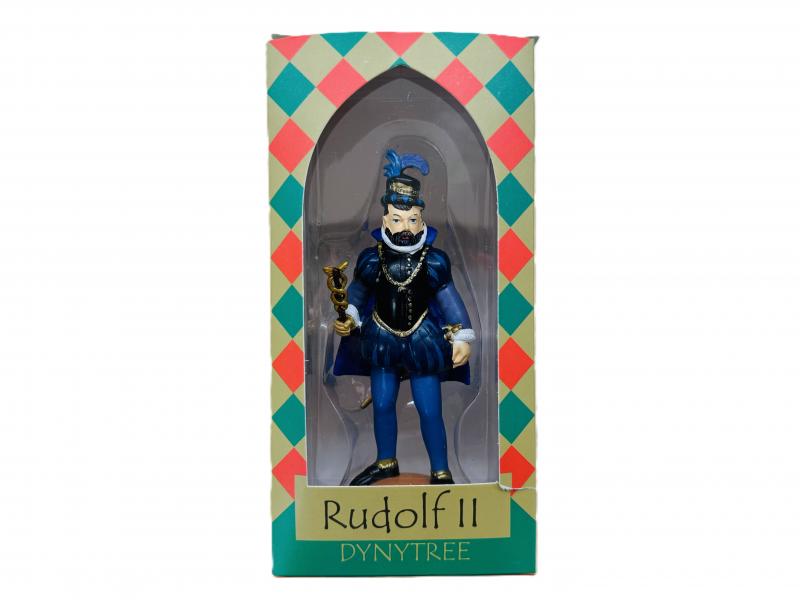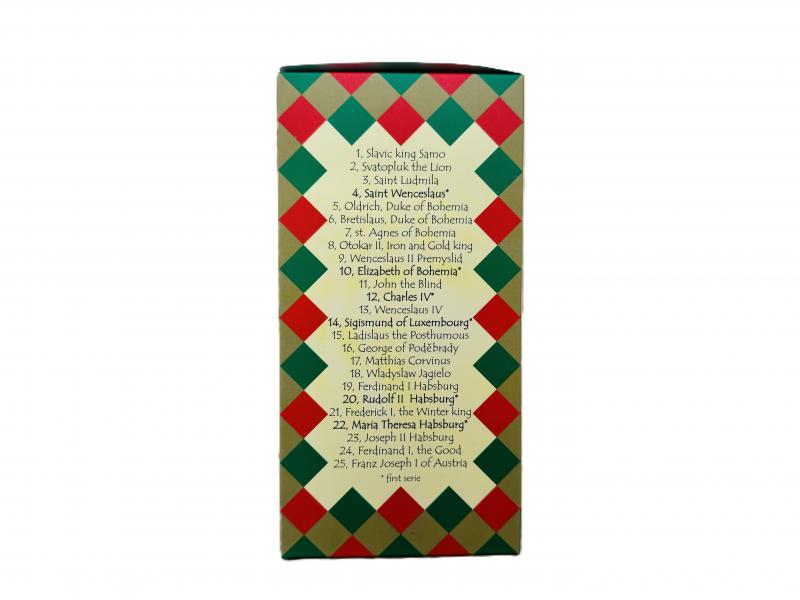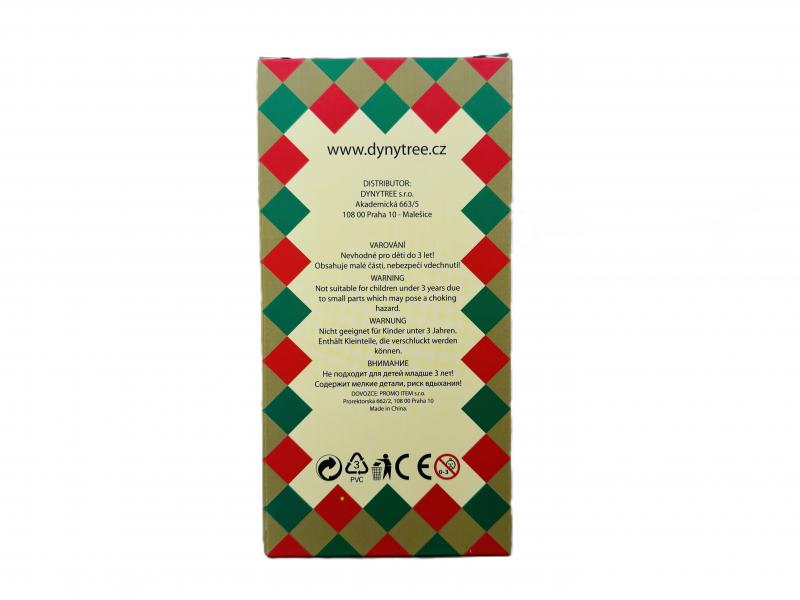K08 Statue of the Emperor Rudolf II.
Rudolf II Figure - a gift and souvenir especially for visitors to Prague, which Rudolf II chose as his residence. Celý popis
Overview
Rudolf II Figure - a gift and souvenir especially for visitors to Prague, which Rudolf II chose as his residence.
What to Expect
Description
The figure depicts Rudolph II in middle age, dressed in typical male clothing of the time, with clear influences of Spanish fashion, especially the shape of the pants and the high collar with flange. Rudolf II holds the staff of Mercury, symbol of alchemy and alchemists. Around his neck hangs the Order of the Golden Fleece, which he received in 1584.
Details
The figure is made of plastic, hand-painted, 12 cm high, placed in a mica packaging that can be opened and in a paper box of 8x8x16 cm. The figure is CE type-certified 110460 T/NB - toy. The figure comes with a booklet with brief information about the 6 figures of the 1st series in Czech, English and German.
Biography
He was born on July 18, 1552 in Vienna. He was the son of Emperor Maximilian II and Maria of Spain. Rudolph's father was an educated and tolerant man, tolerant even in matters of faith, and throughout his life he sympathized with Protestantism. This frightened the other members of the Habsburg family, as it threatened to alienate the monarch from the Catholic faith. Therefore, Maximilian chose an intolerant Spanish Catholic, daughter of Emperor Charles V, as his wife. The union of a tolerant father and an orthodox mother, complicated by the fact that they were cousins, marked Rudolph's entire development. Rudolph spent the first years of his life at the Viennese court, where his parents argued constantly about his education. Finally, Mary of Spain (with the help of Emperor Ferdinand I) asserted her opinion and Rudolph, together with his younger brother Arnost, were sent to the Spanish court to be educated by their uncle Philip II. Here the brothers spent eight years of their lives, and this stay in one of the most lavish and at the same time most religious courts in Europe marked them for life. Maximilian never quite accepted the departure of his sons, and when he became king of Bohemia he immediately began to seek their return. But Philip II refused to give them up, planning to make one of them his heir instead of his own demented son. It was not until 1571 that the return of the two princes was achieved, when their younger brothers replaced them at the Spanish court and their sister Anne became Philip's fourth wife.
Rudolph brought with him from Spain an above-average education for the time, a predilection for natural sciences, alchemy and a great affinity for art and artists. It was difficult for him to get back into Viennese life. In 1572, Maximilian succeeded in promoting Rudolph as king of Hungary, and after he promised the Bohemian states, even verbally, to respect the “Bohemian Confession”, or religious tolerance, Rudolph was elected king of Bohemia and crowned on September 22, 1575. Later he was also elected king of Rome.
In 1576, Maximilian II died and Rudolph II became full ruler. At first, he rules from Vienna, establishes diplomatic relations and supports recatholization efforts, but not very fervently. The beginning of Rudolf's reign was marked by the ugly intrigues of his brother Matthias. The latter was disappointed that the imperial lands were not divided among the brothers, but that Rudolph became the sole ruler. Matthias secretly left for the Netherlands, where he tried - on his own - to become governor. The emperor was greatly hurt by this behavior. Throughout his life, Rudolph worried about his family members, avoided meeting with them, and perhaps the desire to get as far away from them as possible led Rudolph II to choose Prague as his seat in 1583.
Another reason for the court's move to Prague was the constant threat of the Ottoman Empire over Vienna. Prague underwent a fundamental change: it suddenly went from being a provincial town to being the seat of the monarch and the center of the empire. A bustling construction industry began, and not only courtiers, but also foreign envoys, artists, scientists and craftsmen moved to Prague. Prague Castle grew, and a large number of new buildings, halls and palaces were constructed. Rudolf II created a truly magnificent and dazzling imperial court in Prague. As a collector and supporter of the arts, he gave birth to the enormous “Rudolphine” collections of art and curiosities that are still traditional today. World-renowned and talented artists worked at his court, such as Paulus von Vianen, Adrian de Vries and Giuseppe Arcimboldo. Based on his interest in the arcane sciences, the Emperor created a court of alchemists, where, alongside the oddballs, swindlers and charlatans, the leading scientists and chemists of the time, such as Johannes Kepler, worked. The Emperor was interested in all things mysterious and strange and, according to legend, was also in contact with Yehuda ben Bezalel, known as Rabbi Löw, who was to create and revive the mythical golem at the request of Rudolf II. The Emperor had a large menagerie built in the outbuildings of Prague Castle, called the Court of Lions, where there were not only lions and bears, but also orangutans, large reptiles and even a bird from the island of Mauritius, the extinct dodo. The imperial court was, in the words of a contemporary witness, “a sanctuary for the muses, a haven for artists and scholars, especially painters and astronomers, for whom the emperor was not only a most gracious patron, but also a devoted companion.” The city of Prague enjoyed years of prosperity, peace and development, only interrupted by the first battles of the Thirty Years' War.
Rudolph II was of short stature, with a pale but noble face, with a proud, almost haughty bearing. It is said that in his entire life he was never heard to laugh aloud. Unfortunately, Emperor Rudolf II's entire life was marked by periodic bouts of “melancholy,” perhaps bouts of mental illness. The first of these attacks dates back to 1578. Later, the periodic depressions were joined by symptoms of syphilis. Rudolph withdrew more and more into solitude, limited contact with other people and became very distrustful and irritable. He took less and less interest in government, leaving all powers to his advisors and valets - who, of course, abused them accordingly - and he himself dealt with affairs of state with great delay or not at all. This situation was taken advantage of by his unpopular brothers. When war broke out again with the Ottoman Empire in 1593, Rudolf II remained completely passive and left his relatives free rein. The imperial family met in Vienna and voted in favor of the succession of Rudolph's brother Matthias. As the various countries began to suffer from the Emperor's indecision and passivity, they sided with Matthias, who promised better and certainly more active rule. In this way, Rudolph was losing the support of the estates. In 1608 Matthias gathered an army and marched with it on Prague against Rudolph. Although the Bohemian estates were dissatisfied with Rudolph's rule, they did not want Matthias as their ruler either. The confrontation between the two brothers ended with the Peace of Libya. The agreement stipulated that power would be divided. Matthias became lord of Austria, Hungary and Moravia, and Rudolph retained Bohemia, Silesia and Upper and Lower Lusatia. Czech Protestant circles took advantage of this arrangement and eventually forced Rudolph II to enact a “Majesty” guaranteeing religious freedom. Rudolph never accepted his brother's defeat and as an act of revenge called up the Pasovian army, which plundered and pillaged in all the territories through which it marched. This caused even the Bohemian nobility to oppose the still respected Rudolph. Emperor Rudolph II was forced to abdicate and on May 23, 1611 Matthias was crowned king of Bohemia.
Rudolph II never married, although he spent his life negotiating marriages with various royal courts. Among other things, he considered Queen Elizabeth I of England as a bride. Rudolph left no descendants or legitimate successors. With his mistress, Kateřina Stradová, Rudolph had three sons and three daughters, but he never recognized them as his official descendants. Of these sons, the infamous eldest, Don Julius Caesar, who suffered from mental illness, committed, among other things, the brutal murder of his mistress and died locked in strict isolation in Český Krumlov at the age of 23.
After his abdication, Emperor Rudolph II lived in Prague Castle as a desperate, unhappy, broken man. He is said to have wandered about his chambers, threatened his enemies, refused to see even his closest servants and avoided daylight. He died on January 20, 1612, is said to have been dissected in an undignified manner in the presence of the nobility and buried in St. Vitus Cathedral in Hradčany. He was the last Czech king to find his final resting place in Prague.
Availability
Pick up your product anytime from 09.00 to 16.00 at our GET PRAGUE GUIDE office in Maiselova 5, 110 00, Prague 1 or we can send it to your address by post (shipping is not included in the price of the item).
Customer service phone +420 725 744 770
Thank you, your GetPragueGuide




